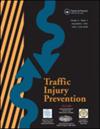美国 16 岁及以上非致命车祸伤者使用药物的五年趋势分析。
IF 1.6
3区 工程技术
Q3 PUBLIC, ENVIRONMENTAL & OCCUPATIONAL HEALTH
引用次数: 0
摘要
目的研究 2019 年至 2023 年在非致命性机动车碰撞事故(MVC)中受伤的个人(16 岁以上)的药物使用流行率,并评估基于美国人口普查地区(即西部、中西部、东北部和南部)的地区差异,从而有助于全面了解与药物有关的机动车碰撞事故:我们研究了美国 19 个州(2019 年 1 月至 2023 年 12 月)的紧急医疗服务数据,以确定在非致命 MVC 事故中受伤的个人(16 岁以上)的年均吸毒率。使用方差分析和Tukey-Kramer检验对吸毒流行率的差异进行评估,以进行年度间比较。使用带有各州随机效应的调整泊松回归模型,将趋势与基线(即 2019 年)进行比较,并评估地区差异:在非致命 MVC 事故中受伤的个人(16 岁以上)中,有 62,310 人报告使用过毒品。方差分析结果显示,非致命 MVC 事故中受伤人员的吸毒流行率存在明显的年度差异,从 2019 年到 2020 年有所上升,随后从 2020 年到 2023 年有所下降(p p 结论:在非致命 MVC 事故中受伤人员(16 岁以上)中,有 62,310 人报告吸毒:在非致命性机动车交通事故中受伤的个人(16 岁以上)中,药物使用流行率在 2019 年至 2020 年期间有所上升;随后下降到 2019 年的基线流行率水平;总体平均车祸相关药物使用流行率没有明显的地区差异。这些发现凸显了在全美范围内进行长期持续监测的必要性。它们还强调了环境风险因素(如 COVID-19 大流行)的潜在影响,以及监测与非致命 MVC 相关的吸毒流行率在未来几年中如何变化的必要性。本文章由计算机程序翻译,如有差异,请以英文原文为准。
Five-year trend analysis of drug use among individuals 16 years of age and older injured in non-fatal motor vehicle crashes in the US
Objective
To examine the prevalence of drug use among individuals (age 16+) injured in non-fatal motor vehicle crashes (MVCs) from 2019 to 2023 and assess regional differences based on US Census regions (i.e., West, Midwest, Northeast, and South), and thereby contribute to a comprehensive understanding of drug-related MVCs.
Methods
We examined emergency medical services data from 19 US states (January 2019 to December 2023) to determine the annual mean drug use prevalence among individuals (age 16+) injured in non-fatal MVCs. Differences in drug use prevalence were assessed using ANOVA with the Tukey-Kramer test for year-to-year comparisons. Adjusted Poisson regression models with random effect for states were used to compare trends to the baseline (i.e., 2019) and to assess regional differences.
Results
Among individuals (age 16+) injured in non-fatal MVCs, 62,310 had reported drug use. ANOVA results showed significant year-to-year differences in the prevalence of drug use among individuals injured in non-fatal MVCs, with an increase from 2019 to 2020 and a subsequent decrease from 2020 to 2023 (p < 0.05). Compared to the baseline year of 2019, the prevalence in 2020 was 1.34 times (95% confidence interval [CI]: 1.12, 1.61) the prevalence in 2019. The prevalence in 2022 and 2023 were similar to the 2019 prevalence. Although no significant associations were found between US regions and the overall mean prevalence from 2019 to 2023; there was a difference in the average annual rate of change in prevalence by region, with a 4.0% lower rate in the Midwest compared to the Northeast (p < 0.001). This signifies a need to monitor future trends for potential regional differences.
Conclusions
Drug use prevalence among individuals (age 16+) injured in non-fatal MVCs increased from 2019 to 2020; then decreased to levels reflecting baseline prevalence in 2019; with no significant regional differences in the overall mean crash-related drug use prevalence. These findings highlight the need for continuous surveillance across the US over an extended period. They also underscore the potential impact of environmental risk factors, such as the COVID-19 pandemic, and the necessity to monitor how drug use prevalence related to non-fatal MVCs changes in the coming years.
求助全文
通过发布文献求助,成功后即可免费获取论文全文。
去求助
来源期刊

Traffic Injury Prevention
PUBLIC, ENVIRONMENTAL & OCCUPATIONAL HEALTH-
CiteScore
3.60
自引率
10.00%
发文量
137
审稿时长
3 months
期刊介绍:
The purpose of Traffic Injury Prevention is to bridge the disciplines of medicine, engineering, public health and traffic safety in order to foster the science of traffic injury prevention. The archival journal focuses on research, interventions and evaluations within the areas of traffic safety, crash causation, injury prevention and treatment.
General topics within the journal''s scope are driver behavior, road infrastructure, emerging crash avoidance technologies, crash and injury epidemiology, alcohol and drugs, impact injury biomechanics, vehicle crashworthiness, occupant restraints, pedestrian safety, evaluation of interventions, economic consequences and emergency and clinical care with specific application to traffic injury prevention. The journal includes full length papers, review articles, case studies, brief technical notes and commentaries.
 求助内容:
求助内容: 应助结果提醒方式:
应助结果提醒方式:


